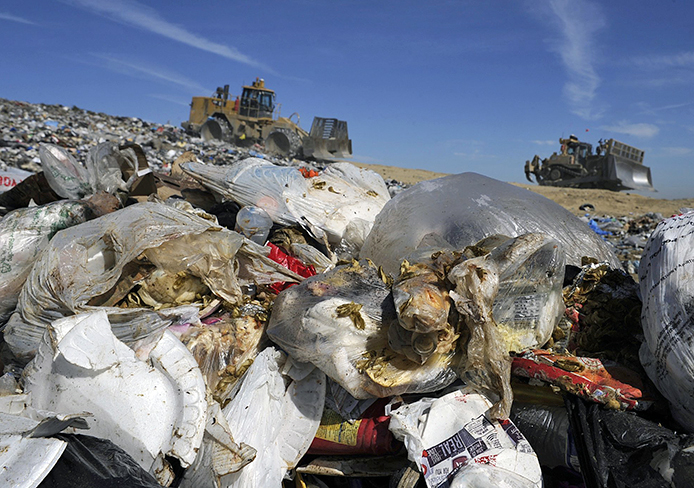
Garbage at the American Avenue Landfill, owned and operated by the County of Fresno, Calif. Keurig recently launched a ‘Grounds to Grow On’ program which turns used K-cups into a useable alternative and ‘Vue,’ a new brewing system aimed at reducing landfill waste. Credit: Courtesy of MCT
We’ve all felt it — that sudden, overwhelming panic, that barrage of pins-and-needles through the skin. It’s 8:01 a.m. You’re late. With the speed and purpose of a drone, you sweep through your bedroom, fumbling manically with coat and keys, backpack and books. Yet even in this helter-skelter state, you manage to click on your Keurig: your heaven-sent hazelnut coffee, your beacon in the night. These compact, single-cup coffee brewers are a staple for countless students, myself included. And yet as I sip, I can’t help but feel a certain tinge of guilt: For with each beverage consumed, so too is one K-cup disposed of, left to fester in a landfill.
The solution seems simple, right? Recycle. And yet to separate the constituent parts of a K-cup — the aluminum top, inner-filter, coffee grounds, and plastic cup — is to invest as much time and energy as would have been spent simply brewing a pot. According to a Keurig representative, this multi-dimensional structure is neither recyclable nor compostable, but is necessary to “maintain coffee freshness.” Yet even so, you can’t help but wonder: Should we really sacrifice sustainability for the sake of freshness and convenience?
“Keurig is currently engaged and aggressively investing in Research & Development to find alternate materials that will be recyclable and/or bio-degradable,” a Keurig spokesperson said in an email Tuesday.
That said, the company’s new “Grounds to Grow On” program turns your K-cup into a useable alternative — for a price. To purchase a Keurig recovery bin, which is essentially a glorified box, you must first pay $50 to $100, depending on the size of the bin you want. They then send you the bins (which you fill with used K-cups and eventually ship back), and abracadabra: your conscience cleared, your guilt absolved, your K-cups recycled. To me, this seems like a glaring inefficiency, like a Band-Aid on a bullet wound. You not only drain your pockets of much-needed cash, but also waste energy and fuel in the sheer transportation of the bins.
In another attempt to curb its waste, Keurig has introduced the Vue — a new brewing system with easy-to-separate, “recyclable” cups. But here’s the issue: While yes, you can now separate the Vue cup’s constituent parts, the recyclability of these parts depends on your location. Columbus, for example, is among 47 percent of American communities able to recycle No. 5 (polypropylene) plastic, the Vue cup’s main ingredient, according to the Keurig representative.
And although Keurig offers a reusable filter, which both eliminates the waste of a K-cup and allows you to hand-select your own coffee, sales of this device pale in comparison to those of single-use K-cups. Green Mountain Coffee (the owner of Keurig) does not disclose the number of K-cups sold per year, though according to The New York Times, the average of six Wall Street analysts stands at 6.9 billion.
In addressing these concerns, a Keurig representative cited Green Mountain Coffee as “ranked No. 1 on the Business Ethics list … two years in a row” for its investment in fair trade coffee. Additionally, the company’s website outlines a number of initiatives designed to decrease waste and minimize impact.
Yet here’s where I struggle: Given the sheer size of the Keurig brand, its waste and impact will always makes a big splash, despite efforts to reduce and minimize. As I see it, these efforts simply mask and perpetuate a greater problem, which is the shortsighted behavior of you and I, the consumer: We continue to buy and take and discard — to enable these companies — even with the knowledge that our habits are unsustainable. Americans will not simply cut caffeine from their routines, let alone swear off the ever-convenient Keurig. We can, however, reduce our intake and pressure companies like Green Mountain Coffee to redesign their products in an effectively sustainable way. We must demand actual change, not initiatives like “Vue” or “Grounds to Grow On,” which operate under the guise of “sustainability” but are in reality inefficient and unrealistic.


